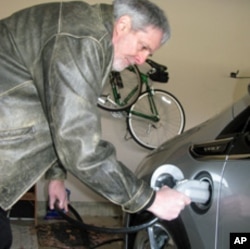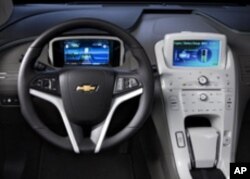Americans are in the market for more energy-efficient and cleaner-running cars. In his State of the Union address to Congress last month President Obama challenged the U.S. automotive industry produce more electric-powered alternatives.
"With more research and incentives we can break our dependence on oil with bio-fuels and become the first country to have one million electric vehicles on the road by 2015," he said.
That message echoed through the cavernous exhibition halls of the 2011 Washington Auto Show, held recently in the nation’s capital, where 700 domestic and imported vehicles were on public display, including new, environmentally friendly, or "green" cars.
Green Car Journal editor Ron Cogan awarded the magazine’s Green Vision Award to Ford for redesigning its best-selling Focus line of gas powered cars into the Ford Focus Battery Electric model. "This is a pretty amazing car. The technology is first rate," he said.
Another crowd pleaser at the show was the all-electric 2011 Chevy Volt, which General Motors introduced as a concept car in 2007 and is on sale in U.S. showrooms.
Cogan says the sleek, aerodynamic four-seater is a milestone in automotive engineering. "It offers the essence of what an electric vehicle should be, with the ability to have an on-board internal combustion engine generator that also creates electricity so you can just continue driving."
High performance
That’s been the experience of Jeff Parmet, a lawyer who works from his home in Potomac, Maryland. He says he hasn’t pumped a drop of gas into his car since he bought it in December. "Ideally I never want to put gas in it. That’s the goal."
The Volt goes about 65 kilometers on a single charge. When the onboard gas generator kicks in to recharge the battery, the car can go up to 480 kilometers between plug-ins.
Parmet says the Volt more than meets his needs. "A lot of people thought it would be like driving a glorified golf cart. That's not the case. This is an engineering marvel. It’s a performance car. It really accelerates fast. It handles great. It corners great. My hat is off to Chevy for what they did with this car. I’m just delighted with it."
General Motors hopes to manufacture 10,000 Chevy Volts this year and another 45,000 in 2012.
On a cold day like this one, Parmet sits at his kitchen table and warms up the Volt by tapping into an application on his mobile phone. A few minutes later in the garage he unplugs the long electric charging cable from the car and stores it in his home power station, a box on the wall about the size and shape of a large bathroom scale.
Next he gets in and pushes a power button to start the car. The car responds in silence. An electronic sound effect confirms that the motor has started. The only noise when he drives is from the wind outside.
Parmet gazes down at his glowing instrument panel. There’s a digital speedometer, a satellite navigation system and buttons to control the radio and the cabin temperature. He also monitors a rear-view camera and a computer screen that calculates battery range, a display with settings for recharging, and a gauge that gives continuous feedback on driver efficiency.
Assessing costs and benefits
Parmet admits that the Volt is expensive. He says while it costs about twice that of a similar-sized car with a gasoline engine, it’s a price he’s willing to pay.
"I bought this car because I strongly believe that we need to move off an oil petroleum-based transportation economy. And I want to make a statement. So I felt that this was an opportunity to do more than just talk the talk."
Parmet sees a bright future for electric cars. He says tighter air pollution controls and higher fuel economy standards have resulted in more efficient gas-powered cars, but he thinks Americans are ready for alternative cars that can achieve much higher energy efficiencies. As more and more electric re-charging stations are installed in public places around the country and as prices begin to come down, Parmet is confident he'll be seeing more and more electric cars joining his on America's highways.

















